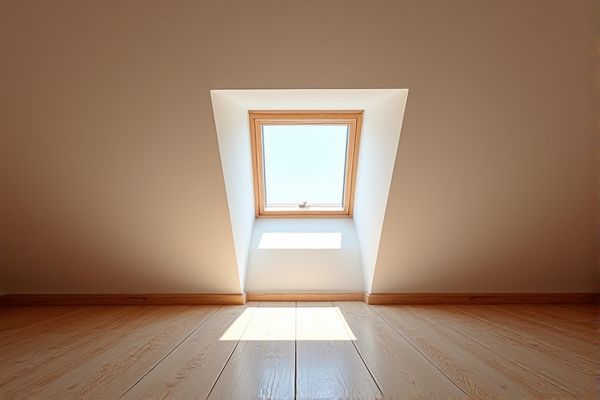
Skylights are fixed, designed primarily for natural light without ventilation, while roof windows open to provide both light and fresh air, making them ideal for attic spaces. Discover which option best suits Your attic renovation needs by exploring the full article.
Table of Comparison
| Feature | Skylight | Roof Window (Attic) |
|---|---|---|
| Definition | Fixed or operable window installed flush with the roof surface | Operable window integrated into an attic roof for ventilation and access |
| Ventilation | Limited or operable; some models open slightly | Fully operable for effective ventilation |
| Installation Location | Any roof slope; often flat or low-slope roofs | Sloped roofs, typically in attic conversions |
| Access | No direct access to roof | Provides roof access for maintenance or emergency exit |
| Light Transmission | High natural light penetration | High natural light with adjustable angles |
| Cost | Generally lower cost | Higher cost due to operability and design |
| Use Case | Primarily for daylighting | Daylighting plus ventilation and roof access |
| Maintenance | Minimal maintenance needed | Requires regular maintenance for movable parts |
| Energy Efficiency | Good insulation when fixed | Good, but potential for air leaks around operable parts |
Introduction to Skylights and Roof Windows
Skylights and roof windows enhance natural lighting and ventilation in attics, offering unique architectural benefits. Skylights are typically fixed, providing daylight without opening capabilities, while roof windows are operable, allowing for fresh air and emergency egress. Both options improve energy efficiency and interior ambiance in attic spaces, contributing to overall home comfort.
Key Differences Between Skylights and Roof Windows
Skylights are fixed, flush-mounted windows designed solely for natural light, whereas roof windows can be opened for ventilation and often include a sash frame. Skylights typically have less insulation and airtightness compared to roof windows, impacting energy efficiency and weather resistance in attics. Roof windows provide greater accessibility for cleaning and escape routes, making them more versatile in residential attic spaces.
Design and Placement Options
Skylights offer versatile design options with fixed or vented models that fit flush with the roofline, ideal for minimalist aesthetics and maximizing natural light in attics with limited wall space. Roof windows, designed to be installed within the roof plane and typically operable, provide more placement flexibility along pitched roofs, allowing for ventilation and easier access for cleaning and emergency exits. The choice influences attic transformation, as skylights create sleek light wells while roof windows enable enhanced views and functionality.
Installation Process Comparison
Skylights are generally installed directly into the roofline, requiring cutting an opening and integrating flashing to ensure waterproofing, which can be more complex and time-consuming than roof window installation. Roof windows, designed for easier retrofit, often involve opening up an existing attic wall or roof frame, allowing for quicker installation with less structural modification. Both require professional sealing and insulation to maintain energy efficiency and prevent leaks, but roof windows typically offer simpler access and integration with interior spaces.
Natural Light and Ventilation Benefits
Skylights provide abundant natural light by being installed flat on the roof, maximizing daylight penetration in attics where wall space is limited. Roof windows, installed within the slope of the roof with operable hinges, enhance ventilation by allowing fresh air circulation and easy access for cleaning. Both options improve energy efficiency by reducing reliance on artificial lighting and promoting airflow, but roof windows often offer superior ventilation control due to their adjustable openings.
Energy Efficiency and Insulation
Skylights and roof windows differ significantly in energy efficiency and insulation, with roof windows typically offering better thermal performance due to their tighter seals and advanced glazing options. High-quality roof windows often feature multi-layered glass and insulated frames that reduce heat loss, whereas standard skylights may allow more air leakage and less effective insulation. Choosing a roof window with energy-efficient coatings and proper ventilation systems can significantly improve attic insulation and reduce heating and cooling costs.
Cost Analysis: Skylights vs Roof Windows
Skylights typically cost between $150 and $600 per unit, excluding installation, while roof windows range from $500 to $1,200, reflecting their larger size and operability features. Installation costs for skylights average $300 to $1,500 depending on roof type and labor complexity, whereas roof windows can exceed $1,500 due to structural modifications required for attic access and ventilation. When budgeting for your attic renovation, consider that roof windows offer added functionality and light control but come with higher upfront and installation expenses compared to skylights.
Maintenance and Durability
Skylights typically require more frequent maintenance due to their complex installation and exposure to weather, which can lead to sealant degradation and leaks over time. Roof windows, designed to open like a traditional window, offer easier access for cleaning and repairs, enhancing their long-term durability. Both options benefit from tempered or laminated glass and robust frames, but roof windows generally provide better ventilation that helps reduce moisture buildup and prolongs the lifespan of attic interiors.
Aesthetic Impact on Interior and Exterior
Skylights create a sleek and modern aesthetic by integrating seamlessly with flat or low-sloped roofs, providing a clean, minimalist exterior appearance while flooding interiors with natural light. Roof windows, designed to be installed within the roof plane, offer a more traditional look with visible frames and can enhance attic spaces by adding architectural character both inside and out. The choice between skylight and roof window significantly affects the visual harmony of the building's facade and interior ambiance, impacting both curb appeal and room brightness.
Choosing the Right Option for Your Attic
Skylights and roof windows both enhance attic spaces with natural light and ventilation, but skylights are fixed and primarily designed for daylight, while roof windows can be opened for airflow. Choosing the right option depends on your attic's ventilation needs, access for cleaning, and overall aesthetic preference. Considering Your attic's layout and intended use will guide you in selecting a solution that maximizes comfort and energy efficiency.
 homyna.com
homyna.com